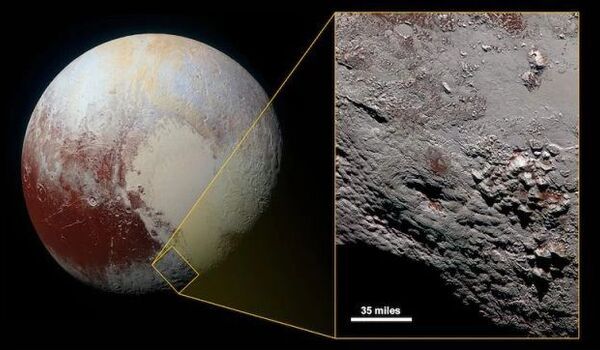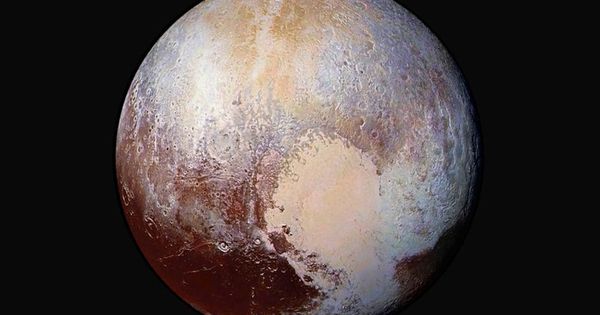An international team of astrophysicists led by the University of Bern and members of the National Center of Competence in Research (NCCR) PlanetS have finally solved the mystery of Pluto’s huge heart-shaped feature on its surface. The team is the first to effectively duplicate the odd shape using computer simulations, putting it down to a massive and gradual oblique-angle collision.
Since the cameras of NASA’s New Horizons spacecraft found a massive heart-shaped structure on the surface of the minor planet Pluto in 2015, this “heart” has perplexed scientists because of its distinctive shape, geological makeup, and height. A team of scientists from the University of Bern, including several members of the NCCR PlanetS, and the University of Arizona in Tucson have used numerical simulations to investigate the origins of Sputnik Planitia, the western teardrop-shaped part of Pluto’s “heart” surface feature.
According to their research, Pluto’s early history was marked by a cataclysmic event that formed Sputnik Planitia: a collision with a planetary body about 700 km in diameter, roughly twice the size of Switzerland from east to west. The team’s findings, which were recently published in Nature Astronomy, also suggest that the inner structure of Pluto is different from what was previously assumed, indicating that there is no subsurface ocean.
The bright appearance of Sputnik Planitia is due to it being predominantly filled with white nitrogen ice that moves and convects to constantly smooth out the surface. This nitrogen most likely accumulated quickly after the impact due to the lower altitude.
Dr. Harry Ballantyne
A divided heart
The “heart,” also known as the Tombaugh Regio, piqued the public’s interest almost immediately after its discovery. However, scientists were immediately drawn to it because it is covered in a high-albedo substance that reflects more light than its surroundings, giving it a whiter appearance. However, the “heart” does not consist of a single ingredient. Sputnik Planitia (the western half) measures 1200 by 2000 kilometers, or roughly one-quarter of Europe or the United States. What is notable, however, is that this region is three to four kilometers lower in height than the majority of Pluto’s surface.
“The bright appearance of Sputnik Planitia is due to it being predominantly filled with white nitrogen ice that moves and convects to constantly smooth out the surface. This nitrogen most likely accumulated quickly after the impact due to the lower altitude,” explains Dr. Harry Ballantyne from the University of Bern, lead author of the study. The eastern part of the “heart” is also covered by a similar but much thinner layer of nitrogen ice, the origin of which is still unclear to scientists, but is probably related to Sputnik Planitia.

An oblique impact
“The elongated shape of Sputnik Planitia strongly suggests that the impact was not a direct head-on collision, but rather an oblique one,” says Dr. Martin Jutzi of the University of Bern, who led the study. As a result, the researchers, along with others across the world, used Smoothed Particle Hydrodynamics (SPH) modeling software to digitally replicate such impacts, altering both the composition of Pluto and its impactor, as well as the velocity and angle of impact. These simulations validated the scientists’ predictions regarding the oblique angle of impact while also determining the impactor’s composition.
“Pluto’s core is so cold that the rocks remained very hard and did not melt despite the heat of the impact, and thanks to the angle of impact and the low velocity, the core of the impactor did not sink into Pluto’s core, but remained intact as a splat on it,” explains Harry Ballantyne. “Somewhere beneath Sputnik is the remnant core of another massive body, that Pluto never quite digested,” adds co-author Erik Asphaug from the University of Arizona. This core strength and relatively low velocity were key to the success of these simulations: lower strength would result in a very symmetrical leftover surface feature that does not look like the teardrop shape observed by New Horizons.
“We’re used to thinking about planetary collisions as extremely powerful occurrences that can be ignored except for energy, momentum, and density. However, velocities in the distant Solar System are significantly slower, and solid ice is much stronger, necessitating far more precise calculations. “That is where the fun begins,” explains Erik Asphaug. The two teams have a long history of collaboration, having investigated the concept of planetary “splats” to explain characteristics on the far side of the Moon as early as 2011. Following our moon and Pluto, the University of Bern team intends to investigate comparable situations for other outer Solar System entities, including the Pluto-like dwarf planet Haumea.
No subsurface ocean on Pluto
The present study also provides new information about Pluto’s interior structure. In fact, a massive impact like the one depicted is much more probable to have occurred very early in Pluto’s evolution. However, this raises a concern: because Sputnik Planitia has a mass deficit, it is predicted to steadily drift towards the dwarf planet’s pole over time owing to physics principles. However, it is paradoxically close to the equator.
The previous theorized explanation was that Pluto, like several other planetary bodies in the outer Solar System, has a subsurface liquid water ocean. According to this previous explanation, Pluto’s icy crust would be thinner in the Sputnik Planitia region, causing the ocean to bulge there, and since liquid water is denser than ice, you would end up with a mass surplus that induces migration toward the equator.
However, the current study provides a different perspective. “In our simulations, all of Pluto’s primordial mantle is excavated by the impact, and as the impactor’s core material splats onto Pluto’s core, it creates a local mass excess that can explain the migration toward the equator without a subsurface ocean, or at most a very thin one,” Martin Jutzi, the study’s lead author, explains. Dr. Adeene Denton of the University of Arizona, a co-author of the paper, is currently working on a new research project to assess the speed of this migration. “This novel and inventine origin for Pluto’s heart-shaped feature may lead to a better understanding of Pluto’s origin,” she said.
















